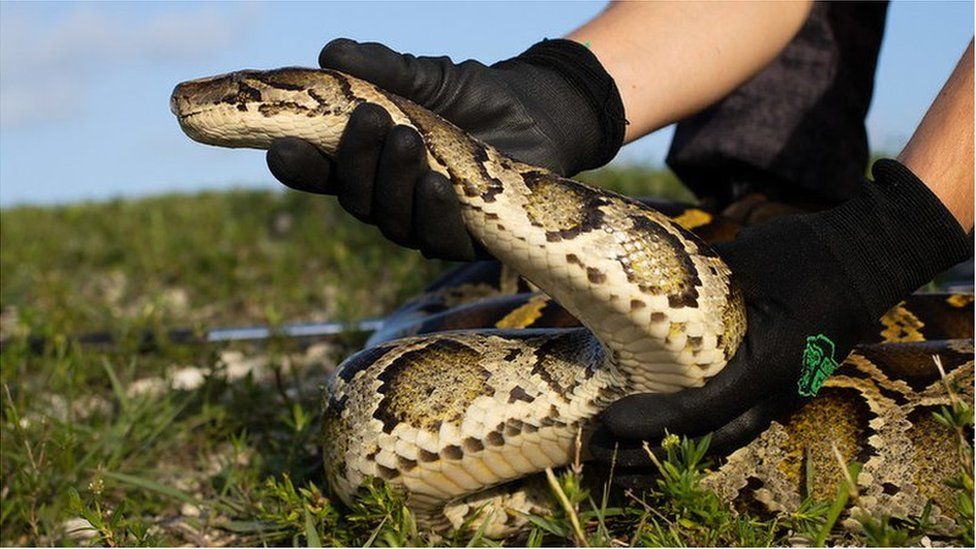ARTICLE AD BOX
 Image source, Florida Fish & Wildlife
Image source, Florida Fish & Wildlife
In the decade since Florida launched its first public contest to kill Burmese pythons, thousands of people from all over the US and around the world have staked their hopes on killing as many of the massive serpents as they can.
Jake Waleri, 22, has one major plan for his summer break from the University of Ohio: hunt snakes.
The native of Naples, Florida, says he's always known about the issue of Burmese pythons, an invasive species that has taken over the Everglades, and the havoc they wreak on Florida's natural habitat.
He became interested in python hunting after watching professional hunters on television, and started hunting them himself two years ago. Last year, he entered the Florida Python Challenge - the state's annual python hunting contest - but dropped out because he was too far behind in the rankings.
"This year I want to win it," he says.
The Florida Python Challenge draws in hundreds of participants each year from as far away as Canada, Belgium and Latvia who are charmed by the prospect of fame and fortune, including up to $30,000 (£23,600) in prize money.
Recent Python Challenge winners include a deaf science teacher who bagged a nearly 16ft snake with his bare hands, a father-and-son duo who rapidly despatched 41 snakes and a 19-year-old who said he would use his $10,000 prize to buy better snake-spotting lights for his truck.
Mr Waleri and his cousin - who call themselves the Glade Boys - plan to hunt snakes every night once the contest begins on 4 August. He says they'll pack energy drinks for the 10-day marathon contest, and "a lot of bug spray - that's important".
He also will carry chest-high waders in case he needs to get into water, a roll of tape to seal the python's mouth before the kill, and a snake stick to move native venomous snakes off the road so they don't get hit by cars.
"If you're not comfortable with snakes, you're going to feel very, very out of place when you're trying to go grab that head," he says.
"When you hesitate - then you got your hand right in front of that snake's head and it's gonna bite you."
Image source, Glades Boys
Image caption,Jake Waleri (right) had been hunting snakes for about two years when he caught a record-breaking 19-ft python
Local conservationists say the contest is necessary in order to curb the scourge that the Burmese python has wrought on Florida's Everglades.
The Everglades contain the largest subtropical wilderness area in the US as well as the largest mangrove ecosystem in the Western Hemisphere. The southern tip of Florida has been described by Unesco as "a river of grass flowing imperceptibly from the hinterland into the sea", which supports a high diversity of flora and fauna.
But Burmese pythons, which were first introduced to southern Florida from Asia via the exotic pet trade in the late 20th Century, has become the largest threat to the region's native species.
Surveys estimate the reptiles, which can be 20ft (6m) long, weigh over 200lb (90kg) and grow about as wide as a telephone pole, have totally eliminated or killed over 90% of some local species, such as racoons, marsh rabbits and possums.
The snakes hide themselves in grasses, wetlands and trees and prey on reptiles, birds, deer and even alligators. They have no local predators that eat them frequently enough to keep their population in check.
The colossal predators, which are also good swimmers and can stay underwater for 30 minutes, outcompete other predators like the endangered Florida panther for food resources.
Harmful parasites they carry have also been discovered inside the lungs of 13 native snake species.
In 2012, one year before the Python Challenge first began, federal officials banned the import of Burmese pythons, but the damage was already done.
Image source, Getty Images
Image caption,Local wildlife in Florida's Everglades has been threatened by the preponderance of pythons
Now, there is an open season on pythons, meaning they can be killed at any time of year, without any permit required and with no limits on how many can be taken.
The contest has drawn criticism from some animal rights groups, including People for the Ethical Treatment of Animals (Peta), who say there should be regulations that require the animals to be exterminated in a humane way, and that it shouldn't be done by amateur hunters.
"We realize that something must be done to fix the exotic-pet trade's mistake, but the true test of a civilization is whether it can solve its problems humanely," the organisation said in a 2019 statement.
A month before this year's contest began, Mr Waleri was chasing pythons through swamps with university friends visiting from cities in Ohio and Illinois, who had no experience catching wild snakes.
But the novices quickly leapt to work when they came upon a 19ft python in Big Cypress National Preserve.
"I thought I was gonna go for a normal head grab and then the thing went absolutely ballistic," Mr Waleri says, explaining that it's necessary to control the head to prevent the snake from biting and beginning to constrict.
"Once it slithered out in the road, I got to see the massive size of this thing and realised we're getting into a fight a little bit more intense than I thought we were getting into," he says.
After they caught it, the snake was declared the largest in the state's history.
Watch man catch Florida's longest-ever Burmese python
'I thought it was a tree'
Brandon Call, a deaf middle school science teacher who grew up with pet snakes and reptiles, took home the prize for largest snake caught by an amateur during the 2021 python challenge, wining $1,500. This year he will be competing for his third time.
Mr Call, who uses American Sign Language to communicate, says he was "handcuffed" while grappling with a snake so large that he at first mistook it for a fallen tree.
With his hands busy, he was unable to tell his stunned friend how to help during the struggle.
"I was more focused on fighting the snake than asking for help," he told BBC News via an interpreter.
This year he plans to hunt with a team of deaf science teachers. He says that deafness gives him a heightened sense of visual awareness that makes it easier to spot camouflaged snakes.
Some of the snakes he kills are brought to school to show his curious pupils, who are also deaf. Sometimes they dissect them as a class project.
"My students are always really excited when I do that."
Image source, Florida Fish and Wildlife
Image caption,Deaf science teacher Brandon Call caught the largest snake of 2021
A drop in the bucket
It's unclear what impact the state-sanctioned killing spree has had on the Everglades ecosystem because experts say it's impossible to know how many are out there.
"The way that we look at it is every single Burmese python that's removed from the Everglades ecosystem is a victory and it's one less of those snakes that's going to be preying on our native birds and mammals and other reptiles," says Carli Segelson who helps host the event for the state's Division of Habitat and Species Conservation.
"So really, you know, every one that's removed is helping the cause."
Bringing attention to the damage caused by invasive species is the contest's highest priority.
"It's an awareness event," says Melissa Miller, an expert on invasive species who researches the python problem at the University of Florida.
"A big huge snake draws a lot of attention."
Pythons are difficult to trap, she says, which makes hunting them even more necessary.
By her estimates pythons spend around 80% of the time completely stationary - rarely moving unless a meal happens to pass by for them to squeeze to death.
They are also expert "escape artists" and are extremely difficult to spot.
"If you had, say, 100 pythons in a given area, and you sent someone out to look for them, they would maybe find one."
Image source, University of Florida
Image caption,Dr Miller has been researching Florida's pythons for more than a decade
Since python removals began in Florida, around 17,000 of them have been removed in total. Only a small number have been killed during the contest, which has grown to become an annual tradition under Governor Ron DeSantis. In addition, the Florida Fish and Wildlife Conservation Commission also runs the Python Elimination Program, which pays "python removal agents" to kill them, and has recently trained dogs to sniff them out.
Another programme involving Dr Miller surgically inserts radio beacons into male pythons, turning them into "scouts" that travel around in search of a breeding female mate.
Most snakes have been found near roads and levees - places where humans can easily reach them. She describes these as the "edges" of their habitat, adding that hunters "are not really getting at the pythons in the interior".
Because 97% of the Everglades are inaccessible without specialised equipment such as a fan boat or a helicopter, it is likely that only a small dent is being made.
Rules of the hunt
Competitors must pay $25 and complete a 30-minute training programme, which focuses on how to correctly identify the snakes and kill them quickly and humanely.
Because it is illegal to transport live pythons without a special permit, most snake hunters must kill any python on site before bringing it to an official weigh station.
The recommended method is called "double-pithing" and is done by stabbing the snake in the head to sever the spinal cord and then swivelling the tool to destroy the brain. Firearms are also permitted when hunting pythons, but only in certain areas where they are otherwise allowed.
Correctly identifying the snakes is crucial. Killing a native snake leads to an immediate disqualification, says Mrs Segelson, one of the contest's organisers.
The radio-equipped "scout snakes" are intended to lead researchers to females - which can lay around 100 eggs each year - and contestants are forbidden from killing the scouts.
The carcasses may be kept or sold. Authorities encourage people around the world to buy python leather from Florida, and discourage hunters from eating them due to their high levels of mercury. But that advice doesn't stop a few dedicated hunters from making everything from python jerky to snake-egg cookies.
Gear up if you want to win
Marcia Carlson Park, a native of New England who has lived in Florida for the last 40 years, hunts pythons year-round because she feels it is her duty to protect the vulnerable habitat.
Mrs Park, who is semi-retired and manages a conservatory for circus performers, says she avoids hunting pythons while the challenge is taking place.
"If I wanted crowds, I'd go into Disney World," she says.
Image source, Marcia Carlson Pack
Image caption,Marcia Carlson Pack with a python she caught
But she wishes all the contestants well, and tells them they better "gear up" for a tough experience in the bush and asks that they be respectful to other hunters as they compete to clean up the Everglades.
People that she sees hunting snakes in flip flops and T-shirts on bicycles in the middle of the day are unlikely to bag many of them, she cautions.
When Mrs Park first began hunting she says there were only a few other women like her, but now there are many.
Together with her friend and professional snake hunter Donna Kalil, who leads a hunting group called the Everglades Avenger Team, Mrs Park has joined several all-female hunts.
To honour the snakes and use every part of the ones they kill, they munch on python jerky as they hunt. They've even made sugar cookies using python eggs, which she says contains more yellow yolk than a chicken egg.
Mrs Park says she's thankful for the global awareness the python hunt brings to the issue of invasive species and the vulnerability of Florida's wetlands.
"There's just no wildlife left. Go down there and try to find a rabbit or a raccoon or something - they just eat everything."
"They eat gators! We've harvested a 15ft python with a 5ft alligator in its belly," she says.
National notoriety
The growing popularity of the Python Challenge has made international headlines - and even inspired a TV show from the producers of Parks and Recreation and Brooklyn 99.
Starring Craig Robinson and Claudia O'Doherty, Killing It follows a team of amateur snake hunters who hope to earn enough prize money to launch a get-rich quick scheme.
Some viewers may be "rightfully horrified at the idea of a state-sponsored animal murdering contest", says Luke Del Tredici, who co-created the show alongside Dan Goor. But when they realise the environmental damage pythons cause, and the need to fight back, it complicates the audience's emotions and makes for a more complex comedic story.
He says the show is supposed to poke fun at the American Dream while satirising humanity's last-ditch battle against climate change.
"It feels like such an apt metaphor. Like you do this thing that's so difficult, and then at the end of the day, you've made such a small dent in the problem," says Mr Del Tredici, speaking to BBC News before Hollywood shut down for the writers and actors strike.
"And that really is funny - or tragic - depending on how you choose to look at it."
Hundreds of people in Florida are being encouraged to hunt Burmese pythons for a cash prize

 1 year ago
48
1 year ago
48








 English (US)
English (US)